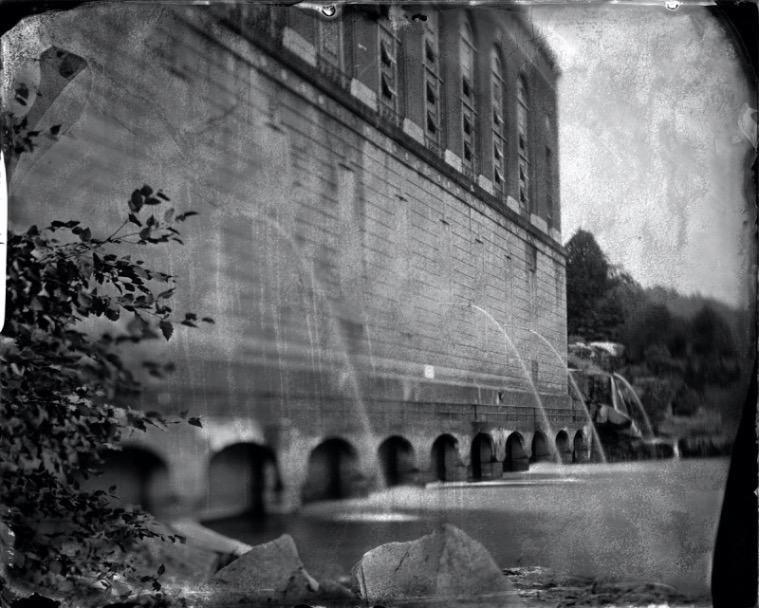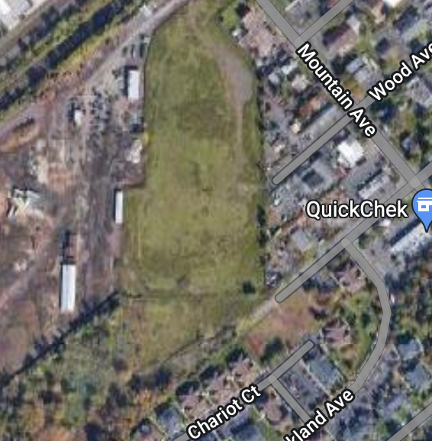Muriel Rukeyser’s The Book of the Dead is a stunning work of hybrid docupoetics. A long poetic sequence, it tells the story of Gauley Bridge and the disaster wrought there by Union Carbide’s hands. In June of 1930, three thousand men began digging a three-mile hole through a sandstone mountain near Gauley Bridge, West Virginia. Union Carbide was building a plant nearby, which required both power and silica, and this tunnel was determined to be the most efficient (and cheapest) source for both. Next, a dam would be built to divert water, and the silica rock mined duri g the tunnel’s excavation would be used in the furnace.

The hydroelectric station on the New River powered by water from the Hawk’s Nest Tunnel and Dam
The workers were not warned of the dangers of silica, and no protective measures were ever taken. By some reports, the dusty conditions turned the workers’ water white as milk. Their lungs would fill with silica in a matter of weeks, forming a scar tissue that made it impossible to breathe in oxygen. An estimated 764 workers died as a direct result. The story was hushed.
“What three things can never be done?
Forget. Keep silent. Stand alone.
The hills of glass, the fatal brilliant plain.”
from The Book of the Dead
In rendering the story of Gauley Bridge into poetry, Rukeyser brought it out of invisibility and into the public eye. As Catherine Venable Moore says in her introduction to the poem, “Poetry can extend the document.” In other words, the document becomes something more. In this extension of the document, Rukeyser collects testimony: interviews with families of the deceased, transcripts from court, even stock market charts are woven throughout her verse. She becomes a bricoleur, piecing together what she has in order to build a more complete narrative, filling in the gaps imaginatively, and using her personal experience to create emotional tenor. I am struck by the ease with which Rukeyser shifts registers, tone, and language.
“In here of course is the swallowing tube, esophagus.
The windpipe. Spaces between the lungs.
Between the ribs?
Between the ribs.”
from The Book of the Dead
In the section titled “THE DISEASE,” we move from the image of the body into the body, and the form breaks across the page. A second voice that enters, questioning the first. A list of questions, indented to the center of the page, interrupts the voice of this poem. It’s like a patient asking a doctor for clarification; a listener confirming the unimaginable. These questions can be read as a correction of what’s being said, or a revision—creating an interview and adding dimension to the story. This poem seems to be a microcosm of the larger story: whose voice do we heed? Who has the answers, the power? What actually happened, and whose version of the story do we trust? I attempted to create a similar experience of discomfort and uncertainty for the reader in my long poem “The Book of Red.”
“In this suburban town, behind
a chain link fence topped by barbed wire is
a monument to the atomic age: a three-acre
mound of radioactive dirt .”
from Sweetbitter
When tasked with telling the story of my own neighborhood—a place also ecologically impacted by the malpractice of Union Carbide (this time, an asbestos factory) as well as by the Manhattan Project—, I turned to Rukeyser for inspiration. She became my navigator, and The Book of the Dead my map. I named my long poem in homage to hers: “The Book of Red.” The centerpiece of my full-length collection Sweetbitter, “The Book of Red” also contains found text, though it is of a very different scope. I include documents from EPA, local newspapers, and the fairy tales I was told as a child. These are the stories that shaped me; the stories I searched out decades later to fill in the gaps.

Like Rukeyser, I honored the gaps, leaving spaces across the page for what I didn’t know—what we’ll never know. I tried to combine the stories I found with my personal experience. I wanted to create a conversation at certain points, inviting the gaps of dialogue.
“Rewritten, recreated, weak, we couldn’t account
for how the story would go
they kept telling us
that there was no health danger
new houses kept going up, and then
the neighborhood pool. It was all
deemed clean
by the standards of the time
But then these guys in white
protective suits
started doing all this digging and
testing
in the early 80’s, just before
we were born, just before we arrived red-faced
from racing to the pool, daring each other
to cross the railroad trestle…
…After all, we always promised
we’d pay attention.”
from Sweetbitter
But how can we see what’s not there? How can we uncover what’s hidden, recreate the stories in their absence? Hybridity may take us there. I see Rukeyser’s “The Book of the Dead” as a roadmap for writing about ecological disaster. Some roads take you into your country. As poets, we’re tasked with following them, in the hopes that we’ll find a way to tell the crucial, evasive stories that otherwise remain unsurfaced.
Stacey Balkun is the author of Sweetbitter & co-editor of Fiolet & Wing. Winner of the 2019 New South Writing Contest, her work has appeared in Mississippi Review, Pleiades, & several other anthologies & journals. Stacey holds an MFA from Fresno State & teaches online at The Poetry Barn. She currently works as Coordinator for the Graduate and Undergraduate English programs at the University of New Orleans.

